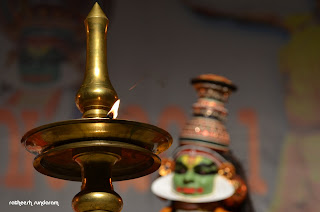Kathakali meaning “story-play” is one of the ancient forms of dance-theater. Kathakali is also known as the King of performing arts. This is because it effectively combines the 5 major fine arts viz. literature (Sahityam), music (Sangeetham), Painting (Chitram), acting (Natyam) and dance (Nrithyam). All these 5 arts are indispensable in the performance of the art.
History: Kathakali is believed to have originated in Kerala in the 17th century. Krishnanattom is often believed to be the forerunner of Kathakali.The Raja of Kottarakara was a leading patron and exponent. Traditionally the performances were night long and with the break of dawn the climax was conducted. With the change in times the recitals are for about 2-3 hours now.
Themes: The popular themes of the Kathakali plays are mythological. Stories from the Mahabharata, Ramayana and the Puranas are the most famous. Nowadays adaptations of Shakespearean plays are also staged.
Costumes: A handicraft specialty of Kerala is the wood items with exquisite carvings. This skill is put to use well in creating accessories for the Kathakali artist. The headgear and other ornaments are carved out by proficient wood carvers of the region. Kathakali is identified with Kerala; the making of Kathakali masks is also quite a business in the state.
Make up: The make up or Chutty is a fine art itself. The painters painstakingly beautify he faces of the dancers. An average face painting could take anywhere between 3-5 hours. Vegetable dyes and items such as Lime, Sulphur, Indigo, Rice paste, Soot and Vermilion etc are used on a base of Coconut oil. Different colors are used to depict the different traits possessed by the characters in the dance. The characters of noble bearing etc would be painted green but the evil of heart would be painted green with red streaks. Extremely evil characters were painted red; inhabitants of the forests were painted black while women and saints were painted.
Music: The entire script, called Kathakali Padam, is using out by two male singers. The Soopanam style of singing is used to accompany the performance. Percussion instruments such as the chenda the maddalam, the ela talam, and the chengila.
Dance: The soft graceful movements as involved in traditional dances are almost entirely absent in Kathakali; the movements are often explosive. Rigorous footwork and a highly developed, intricate language of hand gestures characterize the dance form. Hastalakshana Deepika is followed for hand gestures in Kathakali. There are about 24 basic mudras and about 470 symbols in all. The facial expressions are all derivations of navarasa or the nine emotions- Sringaaram (amour), Haasyam (ridicule, humour), Bhayam (fear), Karunam (pathos), Rowdram (anger, wrath), Veeram (valour), Beebhatsam (disgust), Adbhutham (wonder, amazement), Saantham (tranquility, peace).
The training for Kathakali is intensive and requires real girth. Often training starts at childhood and it takes many years before an artist gets to perform.
Some important centers of Kathakali learning in Kerala are – - Margi, Thiruvananthapuram, Thiruvananthapuram District. R.L.V. Thripunithura, Ernakulam Dt.
- Cochin Cultural Centre, Cochin, Ernakulam District Art Kerala, Valanjambalam, Ernakulam District
- Kerala Kalamandalam, Cheruthuruthy, Trissur District. P.S.V. Natyasangham, Kottakkal, Calicut District.
- Gandhi Seva Sadanam, Pathirippala, Palakkad District
- Unnayivarrier Smaraka Kalanilayam, Iringalakkuda, Thrissur District
|











No comments:
Post a Comment